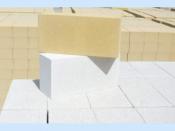Search
Login
Heat recovery
The climatic features of our country, in cold weather, lead to the need for air heating. But by consuming heated air we produce a decay product, as a result of which, for normal life, a change of heated air to fresh is necessary. Total, only the air was heated - we drive it out into the street, the new incoming air is heated again. Recuperators are used to catch the heat of the outgoing air and transfer this heat to the incoming.
Content
- Supply and exhaust ventilation with heat recovery - what is it? video
- Benefits of using recuperators video
- Types of recuperators
- Lamellar recuperators
- Disadvantages of plate recuperators
- Absorbent Cellulose Cassettes
- Rotary recuperators
- Disadvantages of Rotary Recuperators
- How to choose a recuperator
- DIY heat exchanger installation video
Supply and exhaust ventilation with heat recovery - what is it?
Supply and exhaust ventilation with heat recovery is still little known to ordinary people. The recuperator is known mainly to specialists.
But this equipment has a great prospect for all consumers who prudently relate to their costs.
In Europe, such devices are widespread, although it should be noted that the climatic conditions there are much milder.
And all this thanks to the energy savings that are expended in air preparation.
Benefits of using recuperators
The use of a plate heat exchanger leads to energy savings of 50 to 80%.
The use of a rotary recuperator saves from 70 to 90% of energy.
The percentage of savings directly depends on the temperature difference between the exhaust and supply air. Installing a recuperator brings significant savings in money, while the unit lasts a long time (with proper maintenance) and over the years financial savings only increase.
The heat recuperator of the supply and exhaust unit partially collects the heat of the exhaust air and transfers it to the incoming air. This allows heat to be returned to the house, while comfortable ventilation of the room occurs.
Using a recuperator, we have fresh air of medium temperature (between indoor and outdoor).
Thus, such ventilation is safer for health and at the same time, the recuperator allows ventilation in an economical way.
The recuperator itself consumes a minimum amount of energy - the supply air is heated by natural heat exchange.
Types of recuperators
Heat recuperators can be in the form of a special module of the supply and exhaust system, or they can be an individual stand-alone device.
In everyday life, plate and rotary recuperators became more widespread.
Lamellar recuperators
Lamellar recuperators consist of plates through which air flows to the air outlet and inlet.
Air flows, in such recuperators, do not contact or mix with each other, i.e. each stream goes its own way, and heat is transferred to the heat exchange cassette.
The heat exchange cartridge consists of several thin plates having a large area.
Typically, these plates are made of aluminum foil or plastic.
Aluminum foil cassettes are cheaper, but the efficiency of plastic cassettes is higher than aluminum foil cassettes.
Disadvantages of plate recuperators
The disadvantages of plate heat exchangers include the formation of condensate.
Condensation forms in the winter due to the difference in supply and exhaust air temperatures.
In winter, the condensate freezes and ice forms.
To combat ice use automation.
When the icing sensor is triggered, the supply air goes past the heat exchanger and this air is heated using a heater.
And exhaust warm air from the building passes through the heat exchanger and defrosts the cassette.
The defrosting process takes from 5 to 25 minutes per hour.
Naturally, no energy saving occurs at this time.
In addition, the design should have a drainage bathtub and drainage water pipe for drainage and condensate collection.
In cases of ice, the recuperator is able to save only 45% of energy.
Absorbent Cellulose Cassettes
To solve the condensation problem, hygroscopic cellulose cassettes are used.
The whole trick is that the walls of this cassette are able to absorb moisture from the exhaust air and transfer this moisture to the incoming stream.
The use of hygroscopic cartridges allows you to recover (return) not only heat, but also moisture from the air. After such procedures, fresh air with a comfortable temperature and humidity enters the room.
Thus, the efficiency increases to 70%, and if the recuperator has a double plate heat exchanger made of absorbent paper, this eliminates the formation of frost and increases the efficiency to 90%.
Important! Cellulose cassettes are not used in rooms with high humidity.
Rotary recuperators
A rotor, which is a rotating cylinder, is mounted in the recuperators.
The cylinder throughout the volume is filled with layered profiled metal, aluminum or steel.
During operation, the rotor drum moves in a circle between the supply and exhaust air.
When passing through the exhaust stream, the plates heat up, when passing through the supply stream, the plates give off their heat.
Heat transfer directly depends on the rotor speed, which is adjustable.
The efficiency of the recuperator reaches its maximum if the rotation speed is automatically adjusted in accordance with the readings of the sensors of the external and internal air temperatures.
Disadvantages of Rotary Recuperators
The disadvantages of rotary recuperators include partial mixing of exhaust and supply air.
Therefore, cleaning filters must be installed at the inlet and outlet. The design of rotary recuperators is more complex and therefore, maintenance of rotary recuperators is performed more often than plate ones.
And yet, despite these shortcomings, rotary models are reliable, have greater efficiency in returning thermal energy, up to 80%.
How to choose a recuperator
When choosing a recuperator, you need to know the required plant performance.
To do this, you need to know the frequency of air exchange, namely: how many times in an hour, a complete replacement of air in the room is performed.
The multiplicity of air replacement for an apartment is 1, and for a country house from 0.5 to 1.
Normally, per person, an air replacement of 36 m3 per hour is required.
Skilled specialists, having familiarized themselves with the plan of the house, will select the necessary model for you.
When choosing a heat exchanger, the lower limit of the operating temperature must be taken into account.
And for Russia, the lower limit has a spread from -5 * C to -40 * s in winter.
DIY heat exchanger installation
There are no fundamental differences between the installation of conventional air conditioners and supply and exhaust systems with heat recovery.
The only thing is that the air conditioner supplies air to the room, and in the recovery system there will be two channels (supply and exhaust).
Installation will cost a little more, since more air ducts are used, but no more complicated than the installation of conventional fresh air ventilation.
To prevent condensation from forming on the walls of the duct, the ducts must be thermally insulated.
It is not recommended to install recuperators in the bedroom, successfully install them in the utility rooms or under the ceiling in the hallway.
When installing, it is necessary to pay attention to the design features of some models, as individual models can only work in a certain position, i.e. flat or vertically.
If the model of the recuperator requires drainage, then this device should be in a warm room, and the water is tilted out to the nearest riser.





